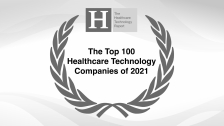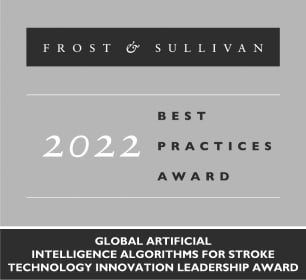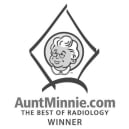At RapidAI, we understand that technology is just one part of any successful patient outcome. From the person who picks up the phone to call 9-1-1, to the first responders, doctors and other healthcare professionals providing care, there are many heroes in each story. Here, we spotlight these incredible individuals who are saving and changing lives in our Rapid Hero Stories.
Mahan Ghiassi, MD has seen a lot during his career as an endovascular neurosurgeon at Norton Neuroscience Institute, but in April 2021, he encountered a first. He treated two family members, an uncle and nephew, within three weeks of each other for the same condition, ischemic stroke. Fortunately, both men had similar positive outcomes.
When the second patient, 61-year-old Paul Nichter (the nephew), was first brought to Norton Brownsboro Hospital, a comprehensive stroke center (CSC) in Louisville, Kentucky where Dr. Ghiassi practices, he was lucky to have been found early. Paul was in his driveway talking to friends who had stopped by when he suddenly felt nauseous. The feeling was quickly followed by an odd sensation that shot down his arms. Paul told his friends he was going to rest and walked into his garage. But as he was about to sit down in a chair, he collapsed, dropping a water bottle he had been holding. The water bottle rolled out of the open garage and down the driveway where his friends, just beginning to drive away, saw it. Feeling something was wrong, they turned back to check on Paul. They found him slurring his words. Paul’s friends, whom he now calls his “guardian angels,” alerted his wife and daughter, who called 9-1-1.
When he arrived at the CSC, Paul was showing signs and symptoms of a Middle Cerebral Artery (MCA) stroke, including facial droop and left-sided weakness, and his National Institutes of Health Stroke Scale (NIHSS) score was 9. As part of Norton Brownsboro Hospital’s stroke protocols, the emergency medicine team including Andrew Rochet, MD, and stroke team including Danny Rose, MD, neurologist, performed CT angiography (CTA) and CT perfusion (CTP) scans.
“The combination of the two is really helpful,” Dr. Ghiassi explained. “The CTA results show us the large vessel occlusion (LVO), but with CTP, we can tell core infarct from penumbra in a timely fashion. That’s what really determines the outcome for most of these patients.”
Because the hospital is equipped with the Rapid imaging platform, Dr. Ghiassi was able to preview Paul’s Rapid CTP results from his mobile phone before he was even on site. He was in a clinic across the street when he received an alert on the Rapid mobile app with the results of Paul’s scan. They revealed that 63 mL of brain was affected by the stroke, but that only 19 mL was infarcted, meaning that there was approximately 44 mLs of salvageable tissue or penumbra. Viewing the hypoperfusion index feature on the Rapid mobile app also gave Dr. Ghiassi visibility into something even more concerning—Paul had 190 mLs of hypoperfused brain tissue in the MCA territory, which explained his symptoms. “That’s a significant amount of brain, and that tissue was at risk of dying if we did not open the blood vessel,” he said.
Knowing quick action was needed to remove the clot that was blocking blood flow to his patient’s brain, Dr. Ghiassi activated his team directly from his mobile phone using the “Go” feature in the Rapid mobile app. This allowed the team to begin prepping the operating room even before Dr. Ghiassi’s arrival on site, saving valuable time. Meanwhile, he reviewed the Rapid results on PACS. The emergent cerebral angiogram confirmed the findings from the Rapid maps and also verified that Paul had a large thrombus in the right MCA artery which was causing over 95% occlusion but not 100% blockage. Left untreated this would have likely led to a large portion of the 190 mLs of hypoperfused brain tissue infarcting.
“The Rapid software helped make the difference in the correct decision to proceed to emergent thrombectomy,” Dr. Ghiassi said.
Using specialized equipment, he removed the clot through an artery in Paul’s wrist, a minimally invasive procedure called a mechanical thrombectomy. Once the clot was removed, brain function returned almost immediately. Paul’s recovery was fast: Two days after the procedure, he was able to return home, just in time for taco Tuesday dinner with his family. To date, he has no significant deficits.
Paul’s uncle, Charles “Duke” Nichter, 89, whom Paul considers his second father, had a similarly impressive recovery. When Duke presented to the ED with signs of a large left MCA stroke, CTA revealed complete blockage of the left MCA. Rapid imaging results revealed 156 mLs of penumbra in the left MCA territory. Duke was taken for an emergent thrombectomy achieving complete revascularization of the left MCA. Following his procedure, he was able to return home after four days in the hospital and did not require physical or speech therapy.
“He’s doing fine now. He’s active and goes outside. He gets a little fatigued, but he’s 89,” Paul said of his uncle’s health. “For both of us to come out needing no speech therapy and having no paralysis, the doctor said we are miracles.”
RapidAI gives stroke teams and their patients more of what they desperately need: time. By notifying the entire stroke care team—doctors, emergency personnel and logistics—at the earliest possible moment and giving them the patient images and information they need to make the best possible decisions, they can save lives.
Paul Nichter’s Rapid CTP results revealed the area of brain affected by his stroke and that a considerable volume of tissue was salvageable based on the mismatch map shown.
The Rapid CTP results also revealed 190 mL hypoperfused brain tissue, shown on this Tmax hypoperfusion map.
Paul Nichter’s pre-thrombectomy angiogram (left) shows the large thrombus in the right MCA artery, indicated by an arrow. The post-thrombectomy angiogram (right) shows restored blood flow after clot removal.
Q: How has the Rapid mobile app improved your stroke workflow?
A: “With the app, I get an alert and can pull up the results very quickly on my phone. We always confirm on PACS, but as soon as I see the results on the app, I can hit the button that says, ‘Go to level 1 stroke,’ which initiates the patient being taken to the hybrid operating room. I can also notify the team from the app to go ahead and open up certain catheters. It all adds up to where we’re cutting 15 minutes or more from each case and opening up the vessel 15 minutes faster.”
Q: How has the use of Rapid CTP impacted your practice?
A: “Six or seven years ago, when CTP was just coming out and helping to guide therapy, we were using a stopwatch. After a certain amount of time, we would just say a patient doesn’t qualify for treatment. Looking back now, it was pretty archaic to do that because we now know there’s huge variability to people’s collateral blood flow in their brains. Someone might be able to live with collateral blood flow for greater than 24 hours. With Rapid CTP, we are now able to forget about the stopwatch and go with the patient’s physiology. As long as there’s an adequate penumbra to stroke ratio, the patient is a candidate for intervention. It doesn’t matter if their last known well was an hour ago or 30 hours ago. Also in more complex cases such as Paul Nichter’s, the supplemental information provided by the Rapid hypoperfusion index gives us additional confidence with our decision to proceed with emergent thrombectomy.”
Mahan Ghiassi, MD
Endovascular Neurosurgeon, Norton Neuroscience Institute


